Pionono de Santa Fé is a cake from the Spanish town of Santa Fe in Granada. Check out our Pionono recipe and prepare it at home.
Have you ever heard of the delectable Spanish dessert Pionono de Santa Fé?
If not, get ready to embark on a sweet and flavorful journey. Originating from the city of Santa Fé in Spain, this pastry treat has captured the hearts and palates of dessert lovers around the world.
In this article, we will explore the history, ingredients, preparation, variations, cultural significance, and more surrounding the Spanish Pionono de Santa Fé.
The Pionono de Santa Fe is made with a slab of sponge cake dipped in syrup, filled with egg yolk and cinnamon, rolled, and topped with a crown of toasted egg yolk.
Where does Pionono originate from?
The Spanish Pionono de Santa Fé holds a rich historical background.
Legend has it that the dessert was created in the 19th century by a local baker, Ceferino Isla González. Santa Fé, a small town in Granada, Spain, became the birthplace of this scrumptious treat.
The name “Pionono” is said to be inspired by Pope Pius IX whom the confectioner Ceferino Isla wanted to honor on the 50th anniversary of his death.
To do so, he created a sweet that recalled his plump figure and was named after him.
Over time, the Pionono evolved into the sweet delicacy we know today, gaining popularity across Spain and beyond.
Read also: Traditional Spanish desserts + recipes
Ingredients Used in Spanish Pionono de Santa Fé
The beauty of Spanish Pionono de Santa Fé lies in its simplicity and the careful selection of ingredients.
The classic recipe calls for eggs, flour, sugar, and a hint of rum or other liqueur for flavor.
However, modern variations have introduced additional ingredients like cream, chocolate, and various fillings to enhance the taste and texture of this indulgent dessert.
Preparation of Spanish Pionono de Santa Fé
Preparing Spanish Pionono de Santa Fé requires skill and precision. The first step involves whisking eggs and sugar together until they form a light and fluffy mixture.
Then, the flour is gently folded, ensuring a smooth and airy batter. The batter is spread onto a baking sheet and baked until it turns golden brown.
Once baked, the thin cake sheet is carefully rolled into a cylindrical shape and cooled. This roll serves as the base for the Pionono, ready to be filled and enjoyed.
Variations of Spanish Pionono de Santa Fé
The versatility of Spanish Pionono de Santa Fé allows for a wide range of delicious variations. One popular variation is the addition of cream, either whipped or pastry cream, as a filling.
This creates a creamy and luscious texture that perfectly complements the sponge cake.
Another variation includes a layer of chocolate spread or ganache, adding a delightful chocolatey element to the dessert.
Some creative adaptations even incorporate fruit preserves, nuts, or dulce de leche for a unique twist.
Serving and Enjoying Spanish Pionono de Santa Fé
Spanish Pionono de Santa Fé is best served chilled, allowing the flavors to meld together.
To enjoy this delightful treat, slice the roll into individual portions and place them on serving plates. You can garnish the slices with a sprinkle of powdered sugar or a drizzle of chocolate sauce for an extra touch of elegance.
Whether enjoyed as an after-dinner dessert or a sweet indulgence during tea time, Spanish Pionono de Santa Fé is guaranteed to satisfy your cravings.
Popular Places to Find Spanish Pionono de Santa Fé
While the origin of Spanish Pionono de Santa Fé lies in Granada, this delectable dessert has gained fame and popularity across Spain and beyond.
Numerous pastry shops, bakeries, and cafes throughout the country serve this delightful treat to locals and tourists alike.
Some renowned places to find authentic Spanish Pionono de Santa Fé include Santa Fé, Granada, and other major cities like Madrid and Barcelona.
Exploring these establishments allows you to savor the true essence of this beloved dessert.
The Cultural Significance of Spanish Pionono de Santa Fé
Spanish Pionono de Santa Fé is more than just a dessert; it holds cultural significance in the region. The dessert is often associated with festive celebrations, family gatherings, and special occasions.
Its presence on dessert tables adds a touch of tradition and nostalgia, reminding people of their heritage and childhood flavors.
Additionally, the popularity of Spanish Pionono de Santa Fé has extended beyond Spain’s borders, making it a symbol of Spanish cuisine and culinary expertise.
Tips for Making Perfect Spanish Pionono de Santa Fé
Creating the perfect Spanish Pionono de Santa Fé requires attention to detail and a few expert tips. Here are some suggestions to help you achieve a delightful outcome:
- Ensure your eggs are at room temperature before whisking them with sugar to achieve maximum volume.
- Be gentle when folding in the flour to maintain the airiness of the batter.
- Roll the sponge cake while it is still warm to prevent cracks and achieve a tight roll.
- Chill the rolled cake before slicing to ensure clean, neat portions.
Following these tips will help you master the art of creating an exquisite Spanish Pionono de Santa Fé in your own kitchen.
How to make Pionono
Bizcocho
1. Line a baking tray with greaseproof paper and grease it with a pinch of butter.
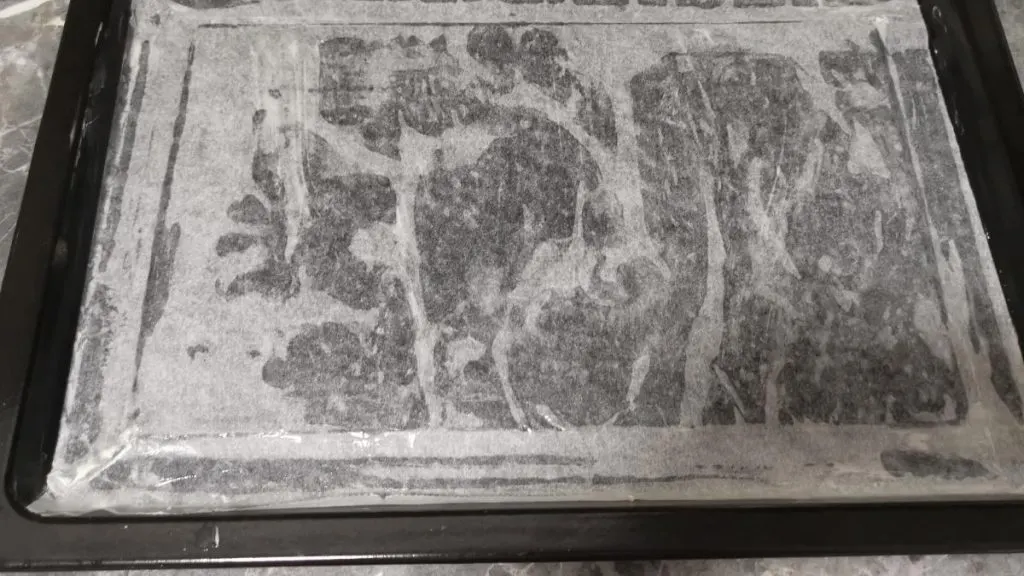
2. Add 0.5 ounces (15 grams) of wheat flour and 0.7 ounces (20 grams) of cornflour to a bowl.
3. Separate the egg yolks from the egg whites and add the egg yolk to the bowl with flour. Set the egg whites aside for later use.
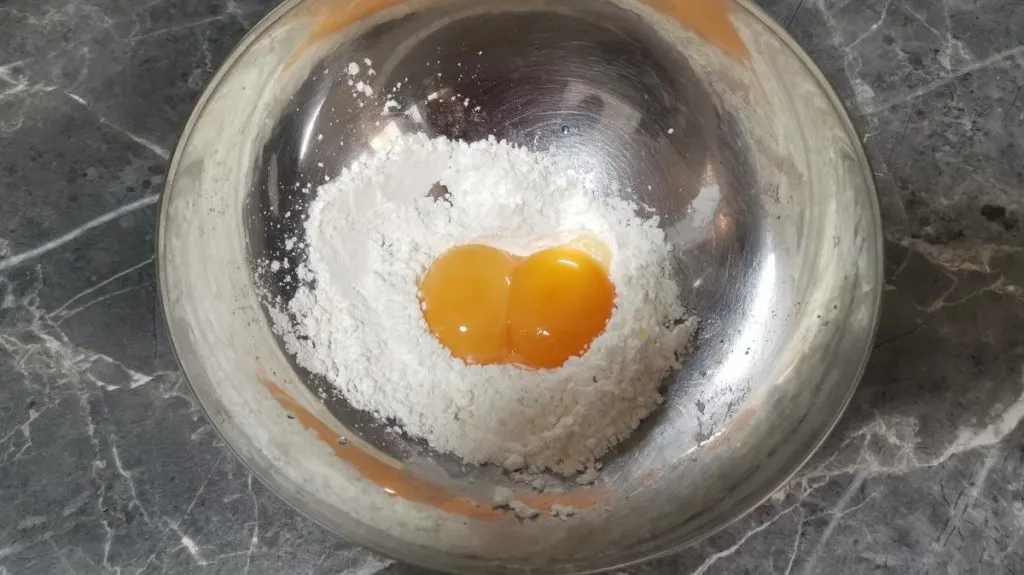
4. Add 1.4 ounces (40 grams) of milk and stir everything until homogenized.
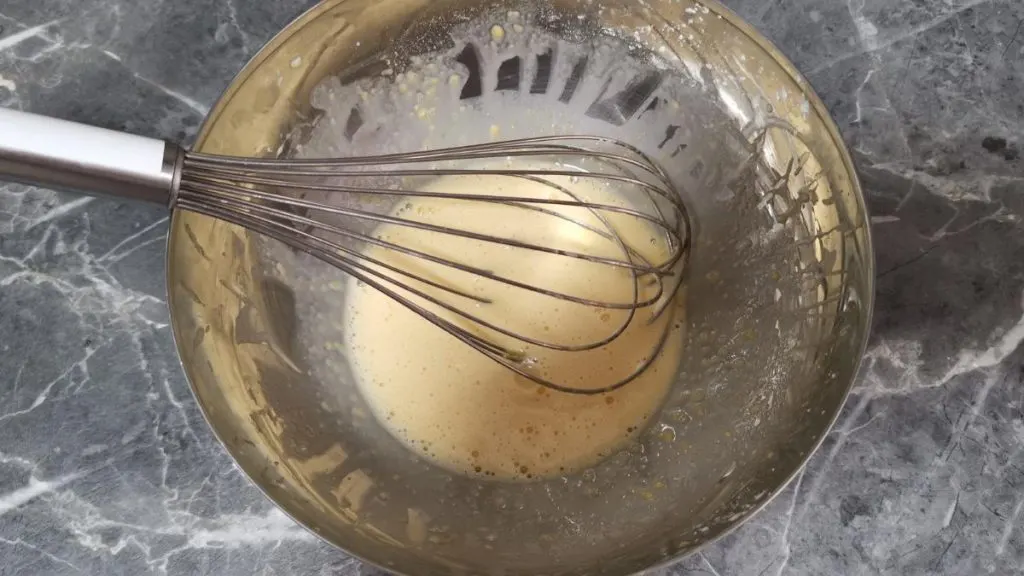
5. Whip the egg whites in another bowl and, when they are foamy, add 1.4 ounces (40 grams) of sugar, little by little.

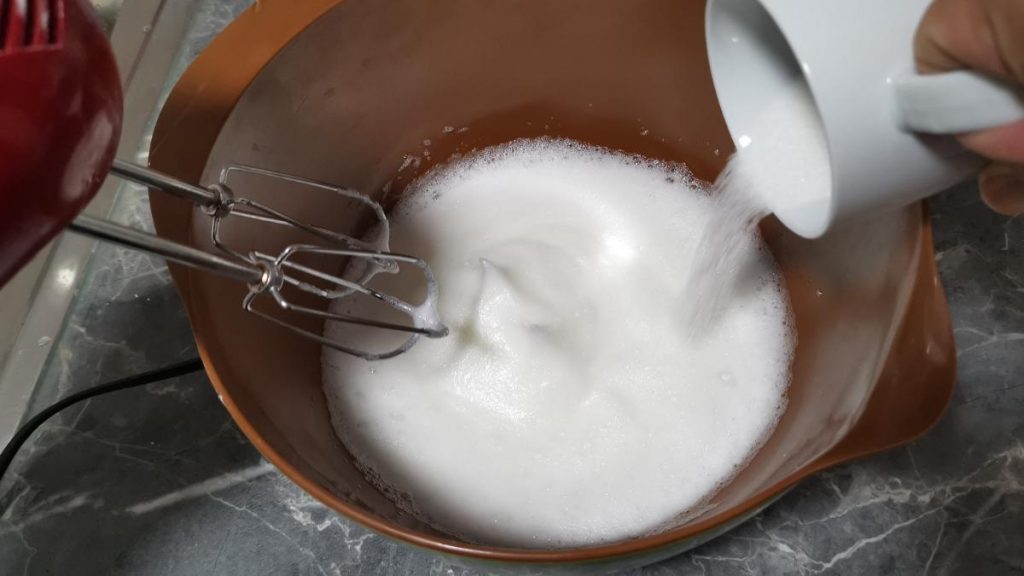
6. Beat until stiff peaks are formed.

7. Add the egg yolk mixture and mix everything well with a spatula. Use smooth and enveloping movements from bottom to top not to lose the air incorporated with the beating.
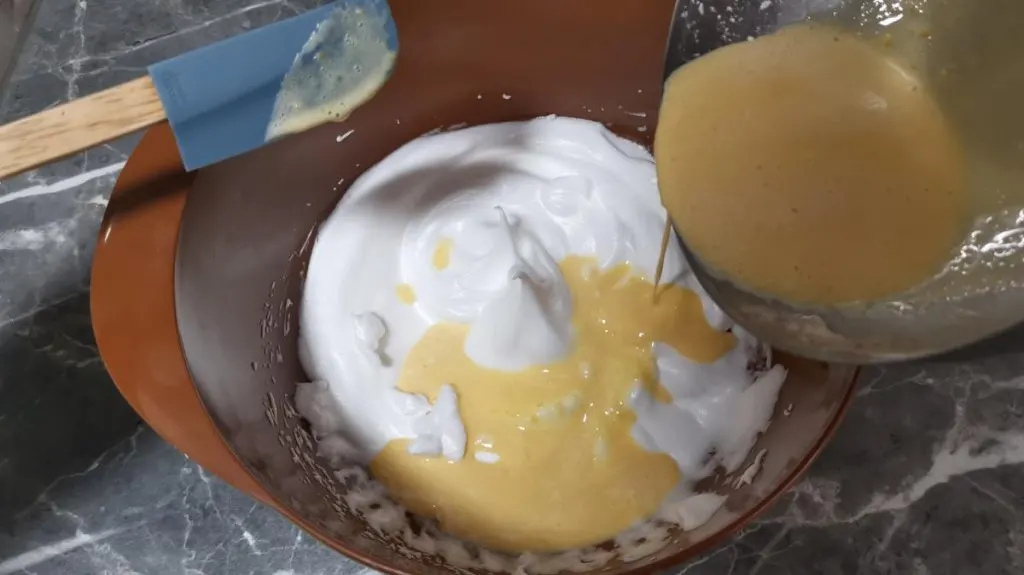
8. Pour the mixture on the baking paper and spread it over the entire surface, ensuring equal thickness.

9. Bake the cake in a preheated oven at 356°F (180ºC) for about ten minutes or until it begins to brown.
10. Remove from the oven and let cool down.
Pastry Yolk
1. Add four eggs to a bowl and weigh them without the shell. Afterward, add 3.2 ounces (90 grams) of water and mix everything.

2. Add the same amount of sugar (in our case, 2.8 ounces or 80 grams) and 0,5 ounces (15 grams) of refined cornflour to another bowl and mix well.

3. Add the sugar/ flour mixture to the bowl with the eggs and mix well until there are no flour lumps left.

4. Heat the mixture over medium heat and stir occasionally. When the mixture thickens, stir vigorously, bring to a boil and remove from the heat. Let it cool down!
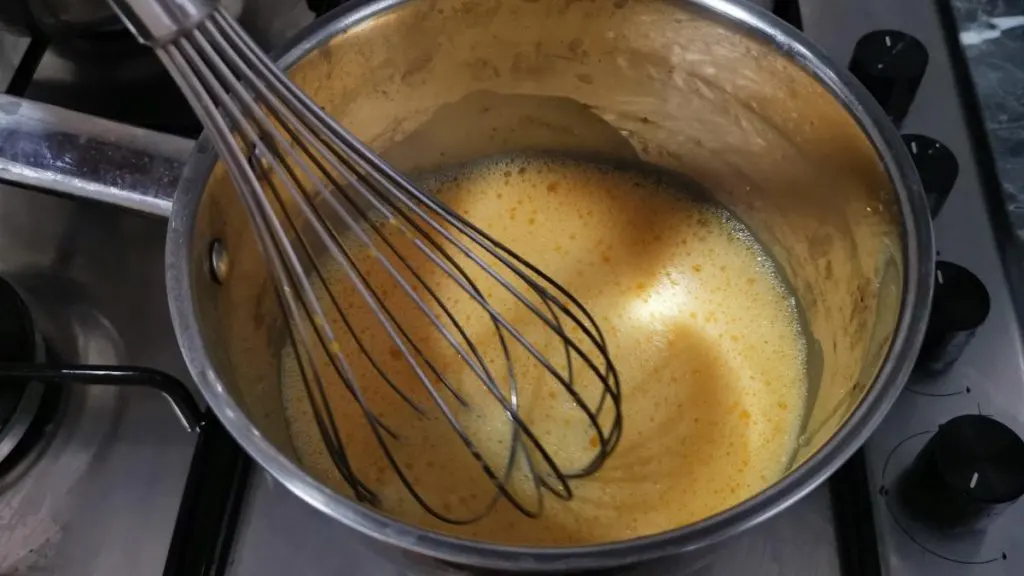
Syrup
1. Add 2.1 ounces (60 grams) of water and 2.1 ounces (60 grams) of sugar to a small pot.
2. Cook over low heat for five minutes. Remove from the heat and let it cool down.
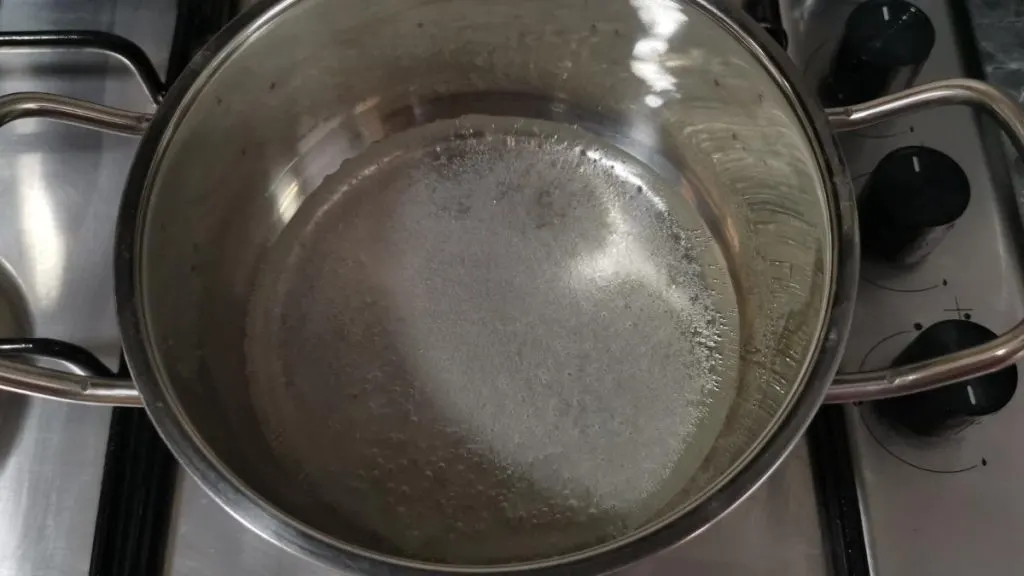
Assembly
1. Brush the sponge cake with the syrup.

2. Cover the sponge cake with the Pastry Yolk (leave around 1/3 of the Pastry Yolk for later to crown the Piononos) and sprinkle with ground cinnamon.

3. Roll the filled sponge cake on the long side and cut it into around 0.8 inches (2 cm) pieces.
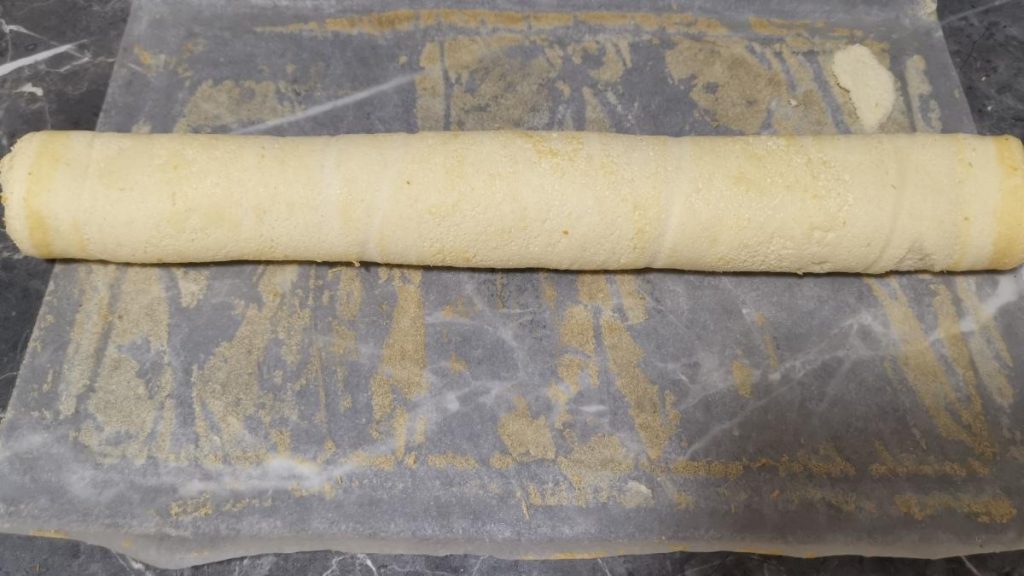

4. Crown each Pionono with a portion of the Pastry Yolk and sprinkle with sugar. Afterward, place the Piononos under the grill for a couple of minutes.

5. Serve immediately or store in the refrigerator.

Spanish Pionono de Santa Fé Recipe
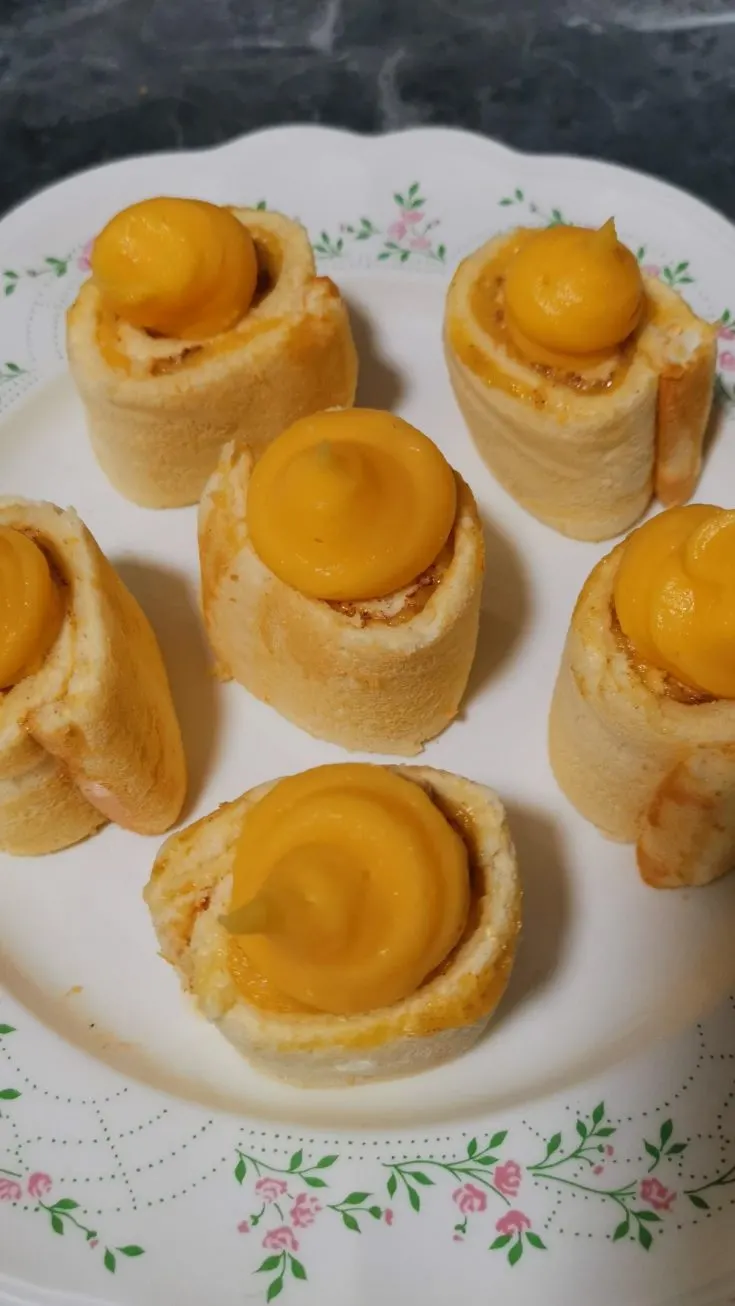
Ingredients
Bizcocho
- 0.5 ounces (15 grams) wheat flour
- 0.7 ounces (20 grams) corn flour
- 2 eggs
- 1.4 ounces (40 grams) milk
- 1.4 ounces (40 grams) sugar
Pastry Yolk
- 4 eggs
- 3.2 ounces (90 grams) water
- Sugar (same weight as the eggs without shell)
- 0,5 ounces (15 grams) refined corn flour
Syrup
- 2.1 ounces (60 grams) sugar
- 2.1 ounces (60 grams) water
Other
- Butter
- Cinnamon
Instructions
Bizcocho
- Line a baking tray with greaseproof paper and grease it with a pinch of butter.
- Add wheat flour and cornflour to a bowl.
- Separate the egg yolks from the egg whites and add the egg yolk to the bowl with flour. Set the egg whites aside for later use.
- Add milk and stir everything until homogenized.
- Whip the egg whites in another bowl and, when they are foamy, add sugar, little by little.
- Beat until stiff peaks are formed.
- Add the egg yolk mixture and mix everything well with a spatula. Use smooth and enveloping movements from bottom to top to not to lose the air incorporated with the beating.
- Pour the mixture on the baking paper and spread it over the entire surface, making sure it is of equal thickness.
- Bake the cake in a preheated oven at 356°F (180ºC) for about ten minutes or until it begins to brown.
- Remove from the oven and let cool down.
Pastry Yolk
- Add four eggs to a bowl and weigh them without the shell. Afterward, add water and mix everything.
- Add the same amount of sugar and refined cornflour to another bowl and mix well.
- Add the sugar/ flour mixture to the bowl with the eggs and mix well until there are no flour lumps left.
- Heat up the mixture over medium heat and stir occasionally. When the mixture begins to thicken, stir vigorously, bring to a boil and remove from the heat. Let it cool down!
Syrup
- Add water and sugar to a small pot.
- Cook over low heat for five minutes. Remove from the heat and let it cool down.
Assembly
- Brush the sponge cake with the syrup.
- Cover the sponge cake with the Pastry Yolk (leave around 1/3 of the Pastry Yolk for later to crown the Piononos) and sprinkle with ground cinnamon.
- Roll the filled sponge cake on the long side and cut it in around 0.8 inches (2 cm) pieces.
- Crown each Pionono with a portion of the Pastry Yolk and sprinkle with sugar. Afterward, place the Piononos under the grill for a couple of minutes.
- Serve immediately or store in the refrigerator.
Nutrition Information:
Yield:
4Serving Size:
1Amount Per Serving: Calories: 803Total Fat: 16gSaturated Fat: 5gTrans Fat: 0gUnsaturated Fat: 9gCholesterol: 287mgSodium: 137mgCarbohydrates: 143gFiber: 12gSugar: 2gProtein: 23g
The nutritional information provided is approximate and can vary depending on several factors, so is not guaranteed to be accurate.
Are you on Pinterest? Pin this!
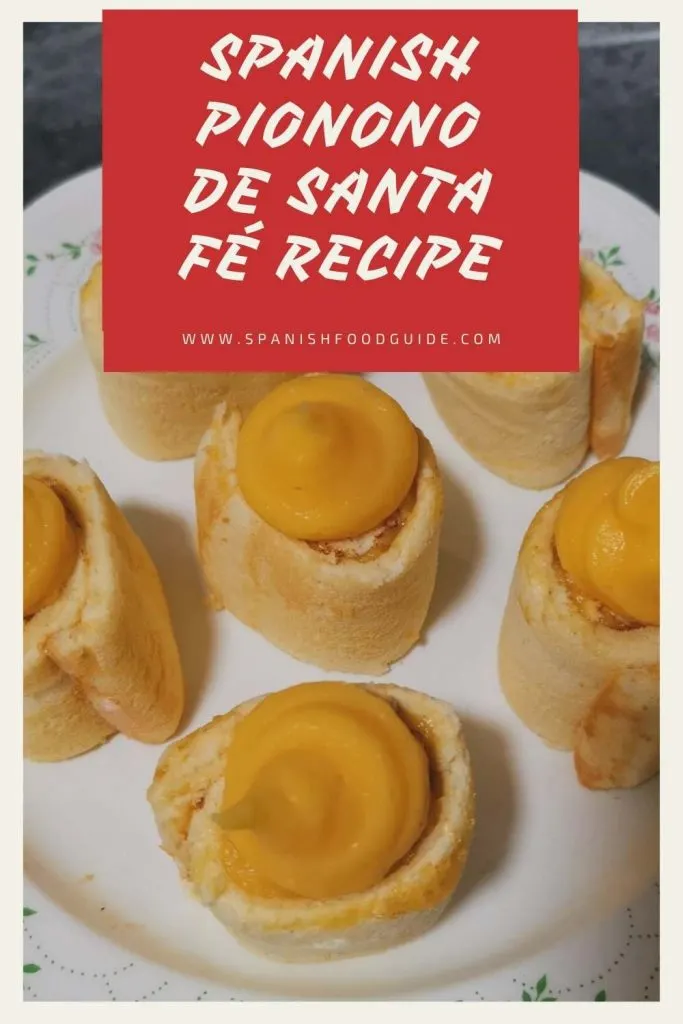
Frequently Asked Questions
Can I freeze Spanish Pionono de Santa Fé?
Yes, you can freeze Spanish Pionono de Santa Fé. Wrap it tightly in plastic wrap or place it in an airtight container before freezing. Thaw it in the refrigerator overnight before serving.
How long does Spanish Pionono de Santa Fé stay fresh?
When stored in an airtight container in the refrigerator, Spanish Pionono de Santa Fé can stay fresh for up to 3-4 days.
Can I use a different type of filling for Spanish Pionono de Santa Fé?
Absolutely! While traditional cream and custard fillings are popular, you can get creative and experiment with fillings that suit your taste preferences.
Is Spanish Pionono de Santa Fé gluten-free?
The traditional recipe for Spanish Pionono de Santa Fé contains wheat flour and is not gluten-free. However, you can find gluten-free variations that use alternative flours.
Where can I find authentic Spanish Pionono de Santa Fé?
Spanish Pionono de Santa Fé can be found in numerous pastry shops, bakeries, and cafes throughout Spain. Some renowned places to find authentic Pionono de Santa Fé include Santa Fé in Granada, as well as major cities like Madrid and Barcelona. Exploring these establishments will allow you to savor the true essence of this beloved dessert.
Where does Pionono originate from?
The Pionono de Santa Fé originates from the Spanish town of Santa Fe in Granada.
What are the ingredients used in Spanish Pionono de Santa Fé?
The classic Spanish Pionono de Santa Fé recipe includes eggs, flour, sugar, and a hint of rum or other liqueur for flavor. Modern variations may incorporate additional ingredients such as cream, chocolate, fruit preserves, nuts, or dulce de leche.
Is Spanish Pionono de Santa Fé difficult to make for beginners?
While making Pionono requires some precision and care, it is not overly complicated. With a clear understanding of the recipe and attention to detail during the rolling process, even beginners can create a delicious Pionono to impress friends and family.



Leave a Reply